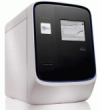Search Thermo Fisher Scientific
줄기 세포를 통한 질병 모델링

Gain advantage with human disease modeling
줄기 세포는 많은 연구 분야중에서도 특히 질병 모델링에 있어 가장 기여도가 큽니다. Induced pluripotent stem cells (iPSCs)의 무한한 원천인 질병의 형태로 나타나는 기증받은 체세포를 reprogramming함으로써 동물 모델없이 인간 세포에 영향을 주는 확장, 분화 그리고 연구가 가능합니다. 생리학적 관련 세포 모델은 질병 체계 개발을 가속화 시킬 수 있습니다.
Our comprehensive tools, protocols and services are designed to help researchers overcome many challenges of genome editing using primary and stem cells to construct human disease models. Combined with recent advancements in genome editing technologies we enable scientists to gain new insights into human diseases and with the advantages of in vitro human disease modeling, including:
- Streamlined isogenic cell line generation
- Unlimited number of human iPSCs
- Controlled experimental setting
- Supports systematic evaluation of genetic mutations
파킨슨 질병 세포 모델 구축
Neurodegenerative disease: neurodegenerative diseases represent a group of neurological disorders that destroy neurons in the brain. Parkinson’s disease (PD) is the second most common neurodegenerative disease, a progressive disorder that affects 1% of people over age 60 and more than five million people worldwide. See the steps our scientists took to model Parkinson’s disease (PD) using human iPSCs
Cardiovascular disease (CVD): cardiovascular/heart disease is the leading cause of death worldwide. With CVD claiming the lives of millions of people each year, the need for scientific research into disease mechanisms and possible therapies is imperative. See the steps our scientists took to model dilated cardiomyopathy (DCM) disease using human iPSCs
On this page:
라이프 테크놀로지스와 California의Sunnyvale에 있는 파킨슨 연구소는 파킨슨 질병(PD)에 내재되어 있는 과정을 개선 시킬 수 있는 약물을 식별하고 세포 모델을 어떻게 개발시킬 수 있는 지에 대해 공동 연구를 진행했습니다. 연구 팀 만나보기 >
백서 시리즈를 통하여, 라이프 테크놀로지스의 기술을 사용한 파킨슨 질병(PD) 세포 모델 생성을 위한 3단계에 대해 확인하실 수 있습니다.
Building relevant iPSC-based disease models
Pluripotent stem cells (PSCs) show promise in many research areas, especially in disease modeling. By reprogramming donated somatic cells exhibiting disease morphology, a potentially unlimited source of induced pluripotent stem cells (iPSCs) offers the ability to expand, differentiate, and study affected human cells without another animal model. Physiologically relevant cellular models can accelerate the discovery of disease mechanisms. Genome editing in induced pluripotent stem cells (iPSCs) has been demonstrated to be highly effective for generating disease models for both monogenic and complex genetic disorders. Using iPSCs to model disease allows researchers to examine how specific types of cells are affected by a disease.

Isogenic disease models that compare healthy donor cells to patient donor cells can introduce high patient-to-patient variability and confound experimental results. Advancements in genome editing technologies such and CRISPR /Cas9 and TALEN systems now enable construction of human isogenic controls with less variability to help mitigate these problems. The ability to engineer cells creates obvious advantages by eliminating genetic variability that occurs from patient to patient, providing more consistent phenotypes with every trial.

Research tools and protocols
We created, modified, and used many protocols while building the cellular disease model case studies. Listed here are the most popular protocols and media used in the stem cell workflow typically employed in our research, grouped into culture, reprogramming and editing, characterization and differentiation workflow segments.
Culture
Reprogramming and genome editing
Characterize
Resources
Scientific posters
Webinars
Support
Related products and services
For Research Use Only. Not for use in diagnostic procedures.
연구 Protocol 및 Webinar
세포 모델 구축을 진행하는 동안 많은 protocol들이 생성되고, 수정되어 사용 되었습니다. 아래 나열된 제품들은culture, engineering, differentiation, characterization으로 나뉘어진 연구 중 줄기세포 workflow에 가장 많이 사용되는protocol과 배지입니다.
연구에 사용된 제품들
라이프 테크놀로지스에서는 과학 연구를 촉진키시는 새로운 도구를 개발하였습니다. 이는 전세계적으로 연구자들의 수적 증가와 기존의 불가능한 질병 영역의 연구를 가능하게 합니다. 라이프 테크놀로지스의 공동연구에 사용된 제품에 대해 확인하시고 지금 바로 귀하의 연구에 적용하실 수 있습니다.

The Attune® Acoustic Focusing Cytometer 는 iPSC와 NSC population의 유전적 표지 발현을 평가하는 마커로 사용됩니다.

The Ion PGM™ Sequencer는 reprogramming에 앞서 공여자의 fibroblast의 추가적인 유전자 변형 확인을 위하여 사용됩니다.

Essential 8™ Medium 은 공여자의 fibroblast로부터 reprogram된후 iPSC에 사용된feeder-free, serum-free배지입니다.

Gibco® PSC Neural Induction Medium (NIM) 은embyoid body (EB) formation 과정없이 7일안에 iPSC로부터 NSC 생성을 가능하게 합니다.

The CytoTune®-iPS Sendai Reprogramming Kit 는 공여자의 fibroblast를 iPSC로 reprogram하는데 사용됩니다. iPSC는integration-free이며 잠재적인 종양형성의 위험이 없습니다.

The EVOS® FLoid® Cell Imaging Station 은 형광 immunocytochemistry를 통한 다양한 단계에서 신경 세포 표지와 만능세포 모양 확인을 가능하게 합니다.

The QuantStudio™ 12K Flex Real-Time PCR System 은 다양한 특성화 연구에 있어 iPSC, NSC의 유전자 발현 분석에 사용됩니다.

The TaqMan® hPSC Scorecard™ Panel 은 iPCS에서 분화 가능성을 확인하고 pluripotency를 평가하는 PCR assay입니다.




